PR
X
Keyword Search
▼キーワード検索
Comments
私はイスラム教徒です@ Re:アイルランド・ロンドンへの旅(その131): ロンドン散策記・アルバート記念碑(Albert Memorial)-2(11/06)
神神は言った: コーランで 『 (21) 人々…
私はイスラム教徒です@ Re:アイルランド・ロンドンへの旅(その122): ロンドン散策記・Victoria and Albert Museum・ヴィクトリア&アルバート博物館-5(10/28)
神神は言った: コーランで 『 (21) 人…
【時間が出来れば、…
 New!
Gママさん
New!
Gママさん
続日本100名城東北の… New! オジン0523さん
岡山県岡山県立森林… New!
隠居人はせじぃさん
New!
隠居人はせじぃさん
ムベの実を開くコツ… noahnoahnoahさん
noahnoahnoahさん
エコハウスにようこそ ecologicianさん
 New!
Gママさん
New!
Gママさん続日本100名城東北の… New! オジン0523さん
岡山県岡山県立森林…
 New!
隠居人はせじぃさん
New!
隠居人はせじぃさんムベの実を開くコツ…
 noahnoahnoahさん
noahnoahnoahさんエコハウスにようこそ ecologicianさん
Calendar
カテゴリ: 海外旅行
ロンドン・テムズ川沿いにある 旧ビリングズゲイト市場(Old Billingsgate Market) の屋根飾り
を
違う角度から見上げて。

黄金に輝く魚の風見(weathervane) をズームして。
違う角度から見上げて。

黄金に輝く魚の風見(weathervane) をズームして。
・魚のデザイン
大きく口を開けた金色の魚で、鱗やヒレが細かく表現されています。これは市場が 魚市場
(Billingsgate Fish Market) だったことを象徴。 日本の鯛焼きの如き姿 。
(Billingsgate Fish Market) だったことを象徴。 日本の鯛焼きの如き姿 。
・方位を示す矢印(N・E・S・W)
装飾的な鉄細工とともに、風向きを示す機能を持っている。
実用性とともに市場のランドマーク的存在。
・象徴性
「ビリングズゲイト」はロンドンにおける魚の取引の代名詞であり、風見の魚は街の人々に
とって 魚市場そのもののシンボル であった。
とって 魚市場そのもののシンボル であった。
1875年に建てられた市場建物に取り付けられ、現在もイベント会場として残る建物の屋上で
輝いていたのであった。
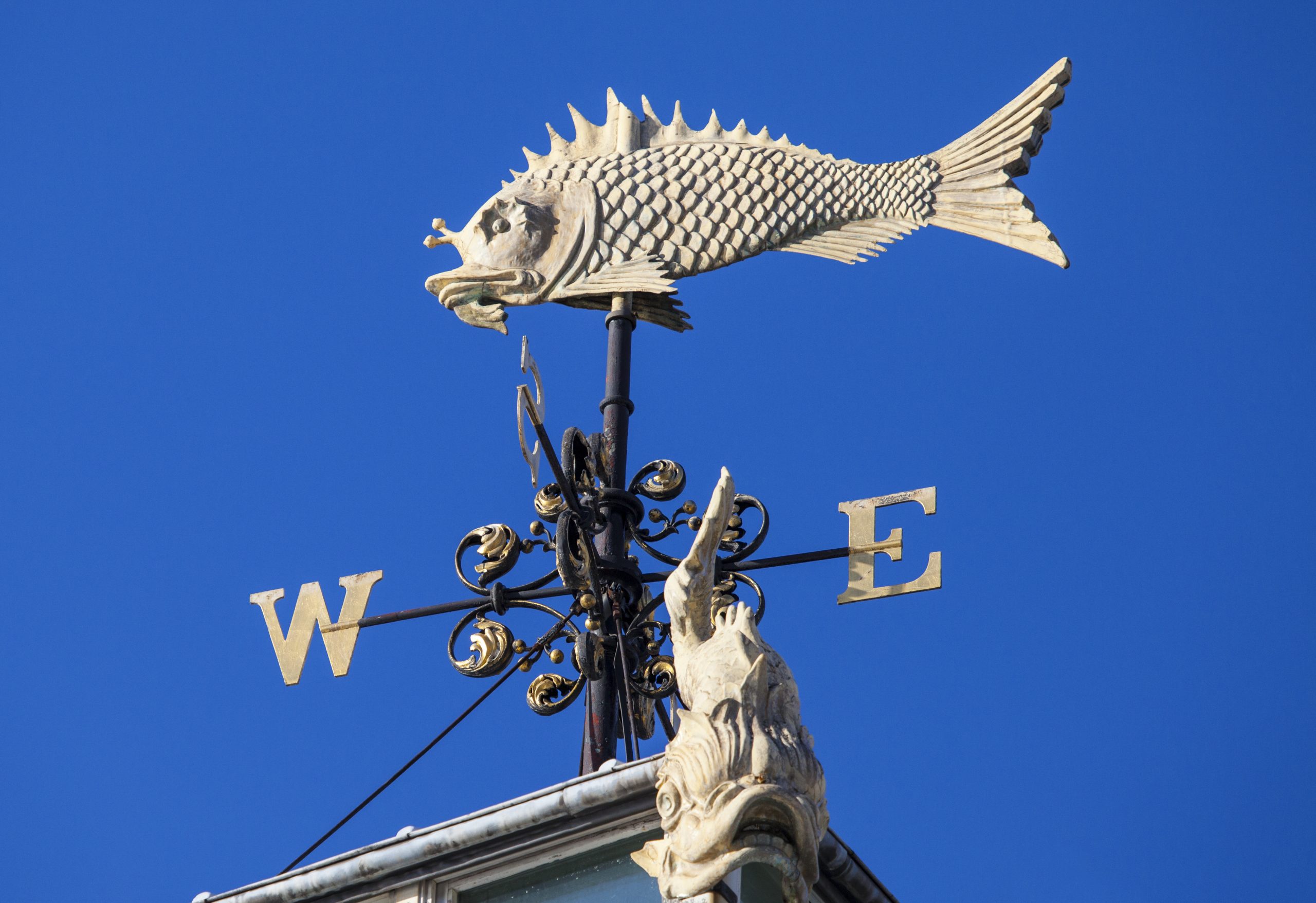
そして旧ビリングズゲイト市場(Old Billingsgate Market)の正面アーチ部分にある
鉄製装飾(wrought ironwork)に近づいて。
1.中央の盾と十字
輝いていたのであった。

そして旧ビリングズゲイト市場(Old Billingsgate Market)の正面アーチ部分にある
鉄製装飾(wrought ironwork)に近づいて。
1.中央の盾と十字
中央には大きな盾があり、その上には ロンドン市のシティ・オブ・ロンドンの紋章
(赤い十字+上部に剣) がデザインされています。
(赤い十字+上部に剣) がデザインされています。
これは、建物が City of London(ロンドン市当局) の管轄であることを示す。
2.魚のモチーフ
盾の下には大きな魚(おそらくサーモンやコッド)が彫られていた。
これは、ビリングズゲイト市場が 魚市場 であったことを象徴。
「金色の魚の風見」と同じく、建物全体に散りばめられた 魚のシンボル の一部。
3.左右対称の装飾
盾の両側にはスクロール(渦巻き模様)やアカンサスの葉飾りがあり、アーチの枠を強調。

ロンドン市(City of London)の 通り名標識 。
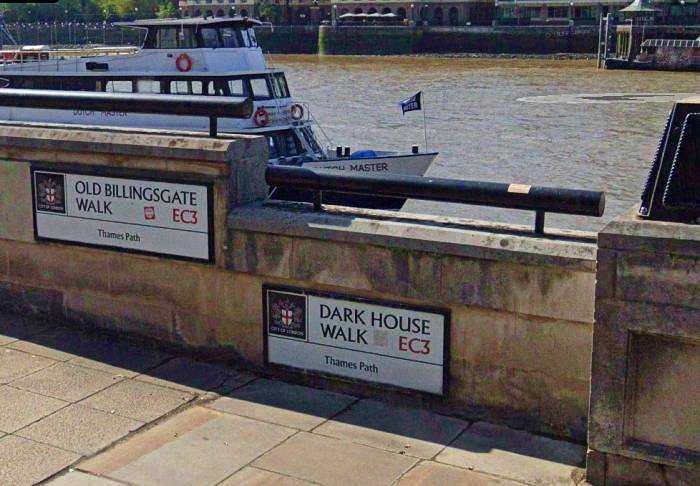
「 Old Billingsgate Walk(オールド・ビリングズゲイト・ウォーク) 」 を示す 通り名標識 。
郵便地区は EC3、さらに Thames Path(テムズ・パス) の一部であることが明記されていた。
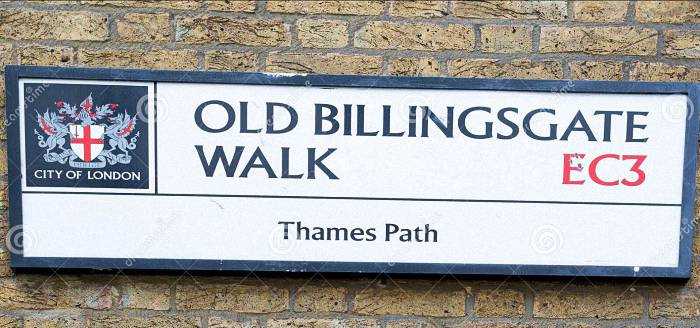
そしてここからは 「 Dark House Walk(ダーク・ハウス・ウォーク) 」。
・周辺はロンドン橋(London Bridge)の東側、カスタムハウス(Custom House)と
旧ビリングズゲイト市場(Old Billingsgate Market)の間にあたる。

ロンドン市(City of London)の 通り名標識 。

「 Old Billingsgate Walk(オールド・ビリングズゲイト・ウォーク) 」 を示す 通り名標識 。
郵便地区は EC3、さらに Thames Path(テムズ・パス) の一部であることが明記されていた。

そしてここからは 「 Dark House Walk(ダーク・ハウス・ウォーク) 」。
・周辺はロンドン橋(London Bridge)の東側、カスタムハウス(Custom House)と
旧ビリングズゲイト市場(Old Billingsgate Market)の間にあたる。
・「Dark House」は、17世紀以前から記録に登場する古い建物名。
・この建物は、船乗りや荷運び人に関連していた倉庫・宿屋であったと。
・「暗い(Dark)」という名は、採光が悪く、川辺に影を落とす建物だったことに由来する と。
・その後、周辺一帯が「Darkhouse Lane(ダークハウス・レーン)」と呼ばれるようになり、
現在に残ったのが「Dark House Walk」である と。
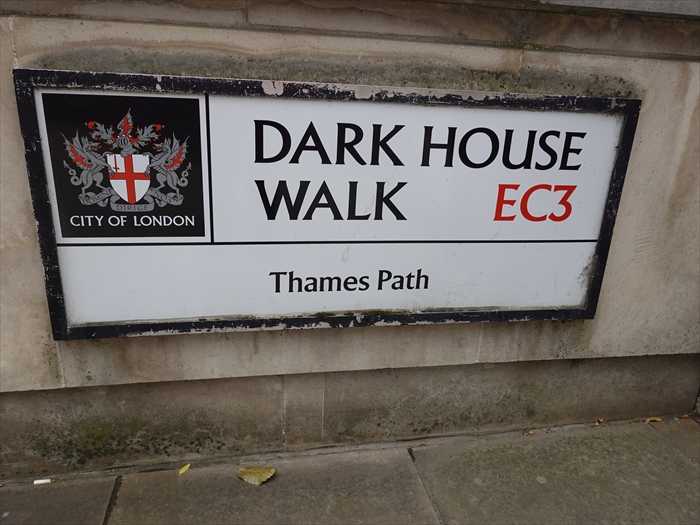
その先の右側のビルの屋上奥から顔を出していた塔が、ロンドンの有名な
モニュメント 「The Monument to the Great Fire of London)・ロンドン大火記念塔」 。

再びテムズ川下流を振り返って。
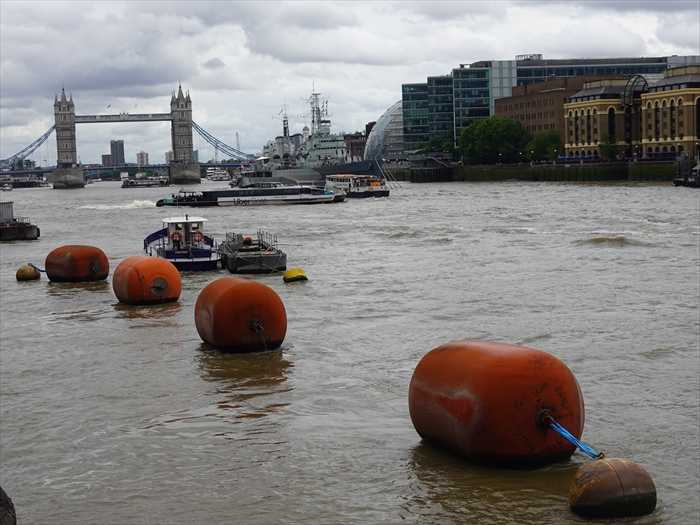
ロンドンの 超高層ビル ザ・シャード(The Shard)・約310メートル(95階建て) 。

現在に残ったのが「Dark House Walk」である と。

その先の右側のビルの屋上奥から顔を出していた塔が、ロンドンの有名な
モニュメント 「The Monument to the Great Fire of London)・ロンドン大火記念塔」 。

再びテムズ川下流を振り返って。

ロンドンの 超高層ビル ザ・シャード(The Shard)・約310メートル(95階建て) 。

・地上1〜40階:赤 オフィス
・地上40〜52階:青 レストラン(Aqua Shard, Hutong, Oblix など)
・地上53〜65階:緑 シャングリ・ラ ホテル
・地上68〜72階:オレンジ 展望台(The View from The Shard)
・地上73〜95階:紫 先端部(サービスフロア+機械室+尖塔)と。

こちらもネットから。

Grant's Quay Wharfを進み、この階段を上り、 London Bridge・ロンドン橋上に向かう。
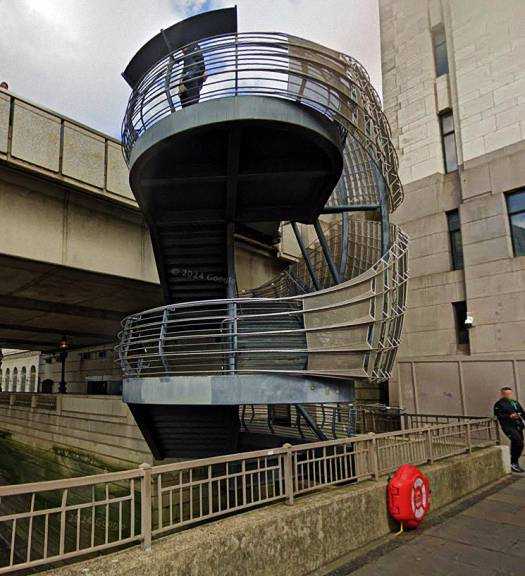
London Bridge・ロンドン橋。
ひときわ高くそびえるのが The Shard(ザ・シャード) 。
歩行者が多く歩いているのが見えた。
現在の ロンドン橋は1973年に完成したコンクリート製の橋 で、歩道が広く確保されていた。
右手に尖塔が見えるのは サザーク大聖堂(Southwark Cathedral)。
ロンドン最古のゴシック教会のひとつで、橋の南詰すぐそばに建っていた。

London Bridge案内板。
「 LONDON BRIDGE
the heads of executed criminals on spikes.」
【 ロンドン橋
います 。 】
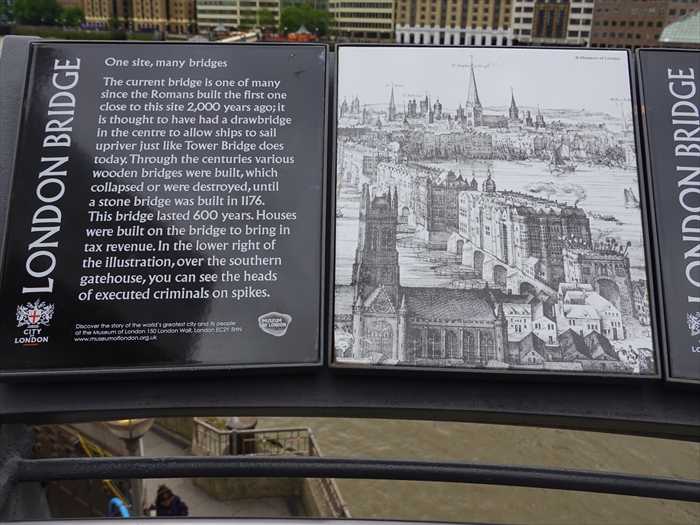
上記の挿絵をネットから。
この挿絵は、中世から近世にかけての 旧ロンドン橋(Old London Bridge) を描いた
有名な図版 の一つ。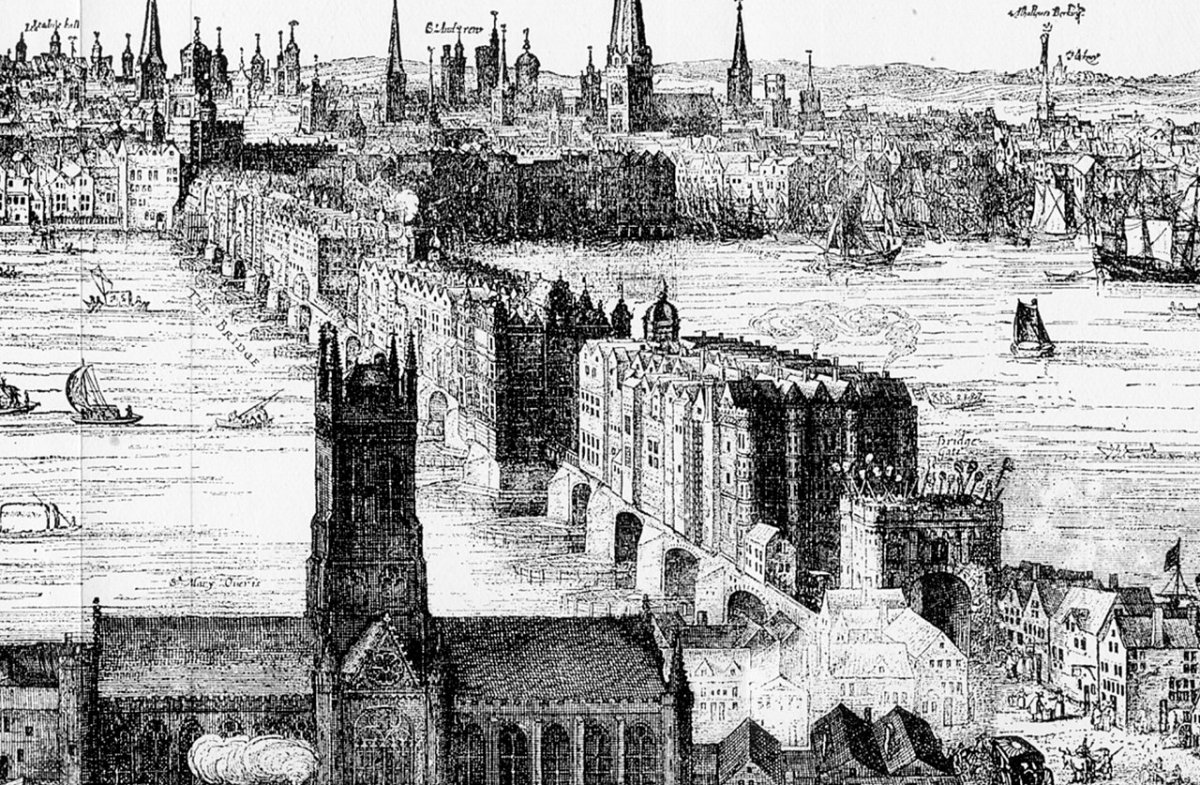
名称を朱記 してみました。
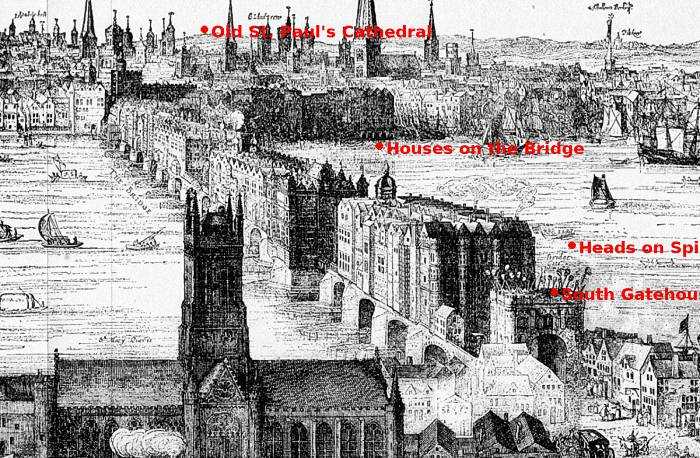
ロンドン橋(London Bridge) に設置されている 「City bridges」の解説 。
「City bridges
and to keep the river safe for transport. They jointly bear the weight of 130,000 vehicles
every day, nearly 50 million a year.」
【 ロンドン橋
City of London(ロンドン市)の地図とともに、テムズ川にかかる主要な橋が示されていた。
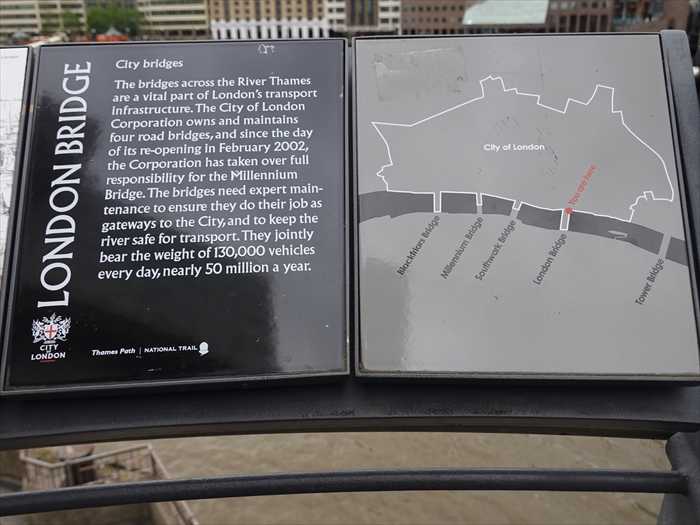
「テムズ川の生物多様性」 についての説明パネル。
「 LONDON BRIDGE
to grow, a base for seaweed and invertebrates, and feeding and spawning areas for fish.」
【 ロンドン橋
魚の採餌や産卵の場を提供しています。】
右側の生物図解

ロンドン橋(London Bridge) に関する
歴史と童謡「 London Bridge is falling down 」 👉️リンク に触れたもの
「 LONDON BRIDGE
the medieval bridge of 1176, which lasted six hundred years, a vast period of time
in which it partially collapsed twice and was severely damaged in the Great Fire of 1666.」
【ロンドン橋
深刻な損傷を受けました。】
右手には歌詞が。
「London Bridge is falling down,
Falling down, falling down
London Bridge is falling down,
My fair lady.
Build it up with wood and clay,
Wood and clay, wood and clay,
Build it up with wood and clay,
My fair lady.
Wood and clay will wash away,
Wash away, wash away,
Wood and clay will wash away,
My fair lady.」
【ロンドン橋落ちた、落ちた、落ちた
わたしの美しい人】
この童謡「London Bridge is Falling Down」はイギリスの子どもの遊び歌で、橋の崩壊と再建を
繰り返し歌にしている点が特徴。
実際にロンドン橋は、歴史上何度も崩壊や焼失を繰り返してきた と。

引き返して、 King Willliam Street の歩道を北に向かって歩く。
左手の建物は Fishmongers Hall(フィッシュモンガーズ・ホール) 。
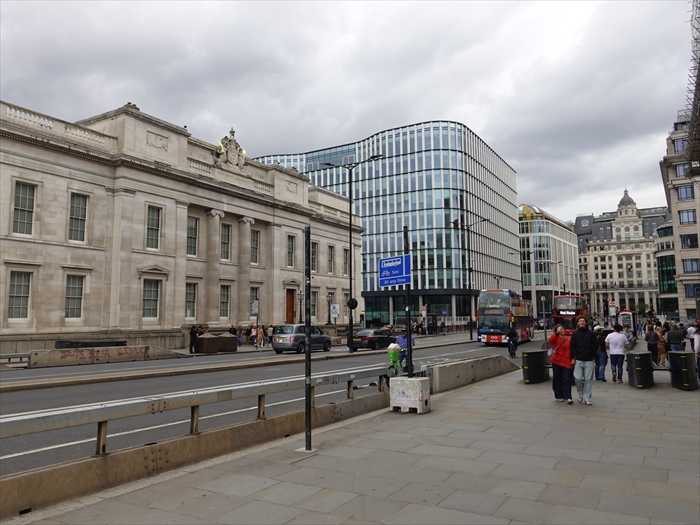
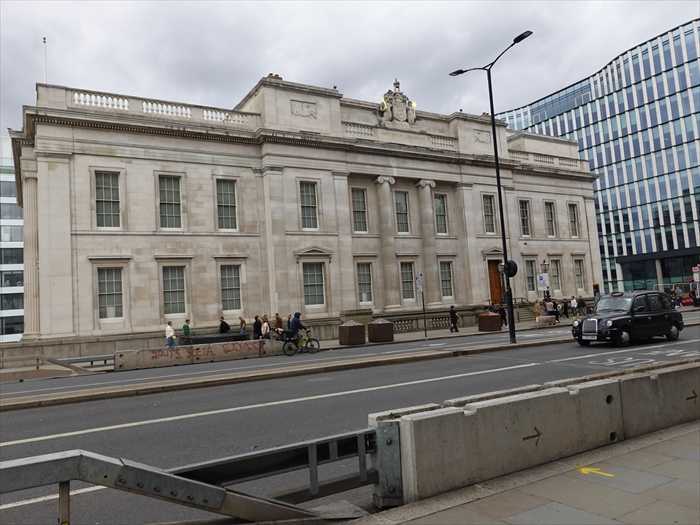
ロンドン橋(London Bridge)の北詰側 、 シティ・オブ・ロンドンに入る方向 の景観。

こちらもネットから。

Grant's Quay Wharfを進み、この階段を上り、 London Bridge・ロンドン橋上に向かう。

London Bridge・ロンドン橋。
ひときわ高くそびえるのが The Shard(ザ・シャード) 。
歩行者が多く歩いているのが見えた。
現在の ロンドン橋は1973年に完成したコンクリート製の橋 で、歩道が広く確保されていた。
右手に尖塔が見えるのは サザーク大聖堂(Southwark Cathedral)。
ロンドン最古のゴシック教会のひとつで、橋の南詰すぐそばに建っていた。

London Bridge案内板。
「 LONDON BRIDGE
One site, many bridges
The current bridge is one of many since the Romans built the first one close to this site
2,000 years ago:
2,000 years ago:
it is thought to have had a drawbridge in the centre to allow ships to sail upriver just like
Tower Bridge does today.
Tower Bridge does today.
Through the centuries various wooden bridges were built, which collapsed or were
destroyed, until a stone bridge was built in 1176.
destroyed, until a stone bridge was built in 1176.
This bridge lasted 600 years. Houses were built on the bridge to bring in tax revenue.
In the lower right of the illustration, over the southern gatehouse, you can seethe heads of executed criminals on spikes.」
【 ロンドン橋
一つの場所に、多くの橋
現在の橋は、この場所に建てられてきた数多くの橋の一つです。最初の橋は、約2000年前に
ローマ人によってこの近くに建設されました。
ローマ人によってこの近くに建設されました。
その初期の橋には中央に跳ね橋があり、船が上流へ航行できるようになっていたと考えられて
います。これは今日のタワーブリッジと同じ仕組みです。
います。これは今日のタワーブリッジと同じ仕組みです。
その後も長い年月にわたり、木製の橋がいくつも建てられましたが、崩壊したり破壊されたり
しました。ついに1176年に石造りの橋が完成しました。
しました。ついに1176年に石造りの橋が完成しました。
この石橋は600年間存続しました。さらに、税収を得るために橋の上には家々が建てられて
いました。
右下の挿絵には、南側の門楼の上に処刑された罪人の首が槍に晒されている様子が描かれていました。
います 。 】

上記の挿絵をネットから。
この挿絵は、中世から近世にかけての 旧ロンドン橋(Old London Bridge) を描いた
有名な図版 の一つ。
1.石造の橋本体
・橋桁は多数のアーチで構成されており、 テムズ川を渡る大規模な石造建築でした
(1176年完成) 。
(1176年完成) 。
・中世ヨーロッパでは珍しい長大橋で、 約600年間使用
されました。
2.橋の上の建物群
・橋の両側に家屋や商店が建ち並び、小さな町のような景観を作り出していました。
・この家並みは課税の対象であり、市の財源として大きな役割を果たしました。
・2階建て、3階建ての木造家屋が密集し、上から見るとまるで通りそのものが川の上に
存在するように見えます。
存在するように見えます。
3.南側のゲートハウス
・手前右側に見える 大きな城門のような建物
が南側のゲートハウスです。
・出入りを管理するだけでなく、 処刑者の首を槍に掲げて晒す場
でもありました。
・イラストでも、 屋根の上に多数の槍と首が描かれています
。
4.テムズ川の船舶
・川には小舟や帆船が航行しており、商業と交通の拠点としての重要性を示しています。
・アーチが狭いため、水流が強く「危険な通航地点」として知られ、船の事故もしばしば
起きました。
起きました。
5.背景のロンドン市街
・奥に多数の教会の尖塔が描かれています。特に高くそびえるのは 旧セントポール大聖堂
(Old St. Paul’s Cathedral) の尖塔 です(現在のバロック様式のセントポール大聖堂の
前身)。
(Old St. Paul’s Cathedral) の尖塔 です(現在のバロック様式のセントポール大聖堂の
前身)。
・ロンドンの都市景観と宗教的中心地を同時に示しています。
ロンドン橋は
単なる交通手段ではなく、 「橋の上に家並みがある町」+「通行・課税の拠点」+
「処刑見せしめの場」という多面的な役割 を担っていたことを理解したのであった。
「処刑見せしめの場」という多面的な役割 を担っていたことを理解したのであった。

名称を朱記 してみました。

ロンドン橋(London Bridge) に設置されている 「City bridges」の解説 。
「City bridges
The bridges across the River Thames are a vital part of London’s transport infrastructure.
The City of London Corporation owns and maintains four road bridges, and since the day
of its re-opening in February 2002, the Corporation has taken over full responsibility
for the Millennium Bridge.
The bridges need expert maintenance to ensure they do their job as gateways to the CityThe City of London Corporation owns and maintains four road bridges, and since the day
of its re-opening in February 2002, the Corporation has taken over full responsibility
for the Millennium Bridge.
and to keep the river safe for transport. They jointly bear the weight of 130,000 vehicles
every day, nearly 50 million a year.」
【 ロンドン橋
シティの橋
テムズ川にかかる橋は、ロンドンの交通インフラにおいて欠かせない存在です。
ロンドン市(City of London Corporation)は4つの道路橋を所有・維持管理しており、
2002年2月の再開以降はミレニアム橋についても全面的な責任を負っています。
2002年2月の再開以降はミレニアム橋についても全面的な責任を負っています。
橋は、シティへの玄関口としての役割を果たし、また川を安全に交通路として利用できるよう、
専門的な維持管理が必要です。
これらの橋は共同で、毎日13万台、年間およそ5,000万台の車両を支えています。】専門的な維持管理が必要です。
City of London(ロンドン市)の地図とともに、テムズ川にかかる主要な橋が示されていた。
左から順に
・Blackfriars Bridge
・Millennium Bridge
・Southwark Bridge
・London Bridge
・Tower Bridge

「テムズ川の生物多様性」 についての説明パネル。
「 LONDON BRIDGE
Aquatic biodiversity
The River Thames is full of life:
at least 115 species of fish and 350 species of invertebrates (like estuarine shrimp or
mud snails).
mud snails).
There are dozen of types of water birds, and dozens more use the river as their
migratory route and feeding ground.
migratory route and feeding ground.
If the river is at low tide, you can see patches of foreshore.
This foreshore is of great ecological importance, as it provides a place for algaeto grow, a base for seaweed and invertebrates, and feeding and spawning areas for fish.」
【 ロンドン橋
水生生物の多様性
テムズ川は生命に満ちています。
少なくとも115種の魚類と、エビやカワニナのような350種の無脊椎動物が生息しています。
また、数十種類の水鳥が見られ、さらに多くの鳥がこの川を渡りのルートや採餌の場所として
利用します。
利用します。
川の水位が下がると、川岸の干潟を見ることができます。
この干潟は生態学的に非常に重要で、藻類が育つ場所となり、海藻や無脊椎動物の基盤となり、魚の採餌や産卵の場を提供しています。】
右側の生物図解
・Signal Crayfish(ウチダザリガニ)
・Roach(ローチ:淡水魚)
・Chinese Mitten Crab(チュウゴクモクズガニ)
・Pike(カワカマス)
・European Eel(ヨーロッパウナギ)
・Seahorse(タツノオトシゴ)
テムズ川は生命に満ちている。少なくとも115種の魚類と、エビやカワニナのような350種の
無脊椎動物が生息しているとのこと。
テムズ川は生命に満ちている。少なくとも115種の魚類と、エビやカワニナのような350種の
無脊椎動物が生息しているとのこと。

ロンドン橋(London Bridge) に関する
歴史と童謡「 London Bridge is falling down 」 👉️リンク に触れたもの
「 LONDON BRIDGE
A bridge to the past
No one knows the real story behind the nursery rhyme about the bridge.
One theory is that it commemorates an attack by the Saxons and Vikings which
destroyed it.
Perhaps a stronger theory is that the rhyme catalogues the slow deterioration ofdestroyed it.
the medieval bridge of 1176, which lasted six hundred years, a vast period of time
in which it partially collapsed twice and was severely damaged in the Great Fire of 1666.」
【ロンドン橋
過去への架け橋
この童謡(ナーサリーライム)の本当の由来は誰も知りません。
一説には、橋を破壊したサクソン人やヴァイキングの襲撃を記念したものとされます。
もう一つの有力な説は、この童謡が1176年に建てられた中世の石橋のゆっくりとした老朽化を
記録したものであるというものです。
その橋は600年間存続しましたが、その間に二度部分的に崩壊し、1666年のロンドン大火で記録したものであるというものです。
深刻な損傷を受けました。】
右手には歌詞が。
「London Bridge is falling down,
Falling down, falling down
London Bridge is falling down,
My fair lady.
Build it up with wood and clay,
Wood and clay, wood and clay,
Build it up with wood and clay,
My fair lady.
Wood and clay will wash away,
Wash away, wash away,
Wood and clay will wash away,
My fair lady.」
【ロンドン橋落ちた、落ちた、落ちた
ロンドン橋落ちた、わたしの美しい人
木と粘土で造ろう、木と粘土、木と粘土
木と粘土で造ろう、わたしの美しい人
木と粘土は流される、流される、流される
木と粘土は流される、わたしの美しい人】
この童謡「London Bridge is Falling Down」はイギリスの子どもの遊び歌で、橋の崩壊と再建を
繰り返し歌にしている点が特徴。
実際にロンドン橋は、歴史上何度も崩壊や焼失を繰り返してきた と。

引き返して、 King Willliam Street の歩道を北に向かって歩く。
左手の建物は Fishmongers Hall(フィッシュモンガーズ・ホール) 。

歴史
・魚商人組合(Worshipful Company of Fishmongers) は、ロンドン市の中でも
最古のギルドのひとつで、13世紀初頭に起源を持ちます。
最古のギルドのひとつで、13世紀初頭に起源を持ちます。
・中世以来、テムズ川を通じた魚の流通・販売の権益を管理し、ロンドン市の食文化と経済に
深く関わってきました。
深く関わってきました。
・現在もロンドン市の Great Twelve Livery Companies(十二大ギルド) に数えられます。
現在の建物は、ロンドン大火(1666年) で焼失した旧ホールを引き継ぐもの。
1834年に完成し、威厳ある石造ファサード、クラシカルな列柱、上部の紋章が特徴的。
内部には、組合の歴史を伝える 絵画・彫刻・記念品 が多数収蔵されている と。

ロンドン橋(London Bridge)の北詰側 、 シティ・オブ・ロンドンに入る方向 の景観。
正面奥に建っている白い石造の大きな建物は
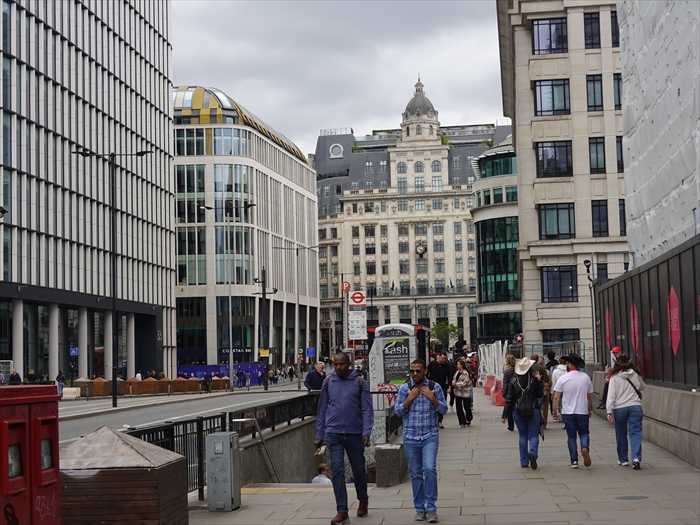
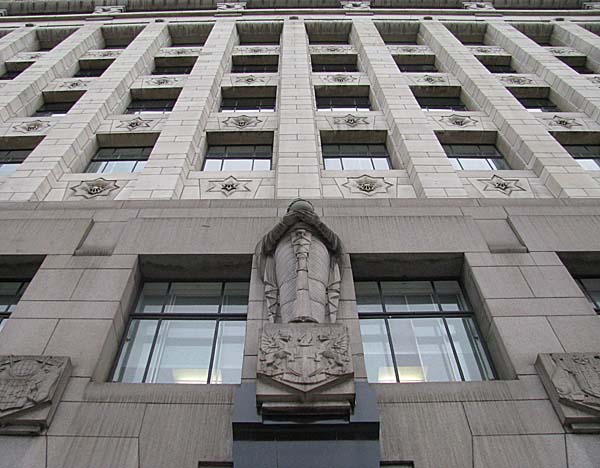
Adelaide Houseのビルの前 にあったのが
「 Rooftop garden in 1930(1930年の屋上庭園) 」 と題された歴史的な写真パネル。
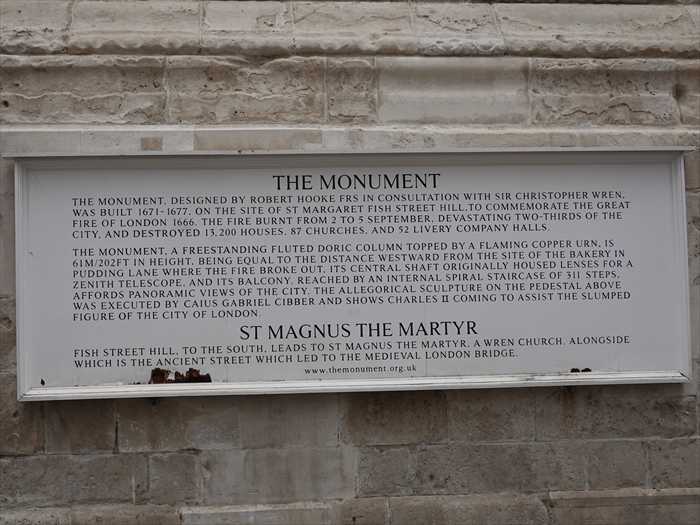
ロンドン大火記念柱(The Monument)基壇のラテン語銘文。
【キリスト紀元1666年9月4日、
都市の東部で火災が発生した。
その後2日間、猛烈な風に煽られた火は、
37の教会、城門、大通り、市場、公共建物、学校、図書館、
そして約13,200軒の家屋を焼き尽くし、
繁栄を誇ったこの都市の大部分を灰燼に帰した。
3日目には、人間の力も手段も尽き果て、
まるで世界全体が最終的な炎で滅びるかのように思われた。
しかし、ついに天の意志により、この宿命の火は鎮まり、
あらゆる場所で燃え尽きた。】

「TRANSLATION OF THE LATIN INSCRIPTION ABOVE

Adelaide House(アデレード・ハウス)
。
・竣工:1925年
・特徴:当時ロンドンで最も高いオフィスビルのひとつ(高さ約43m、10階建て)
・場所:ロンドン橋の北端すぐ横、テムズ川沿いに位置。
・由来:名前はアデレード王妃(Queen Adelaide、ウィリアム4世の王妃)にちなむ と。

Adelaide Houseのビルの前 にあったのが
「 Rooftop garden in 1930(1930年の屋上庭園) 」 と題された歴史的な写真パネル。
・花壇や芝生が整備され、都市の中とは思えない緑豊かな空間が広がっている。
・人々(赤く彩色されている人物たち)は椅子に座って談笑したり、庭を散策したりと、
くつろぎのひとときを楽しんでいるのであった。
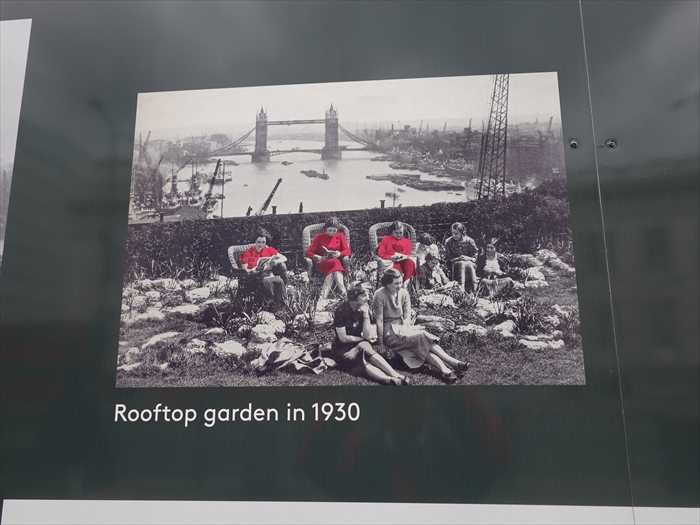
Adelaide House(アデレード・ハウス)の屋上庭園 から見た1930年当時の景観。
・女性がジョウロを持って植物に水をやっている姿は、当時も都会の屋上庭園が生活と直結
していたことを伝えているのであった。
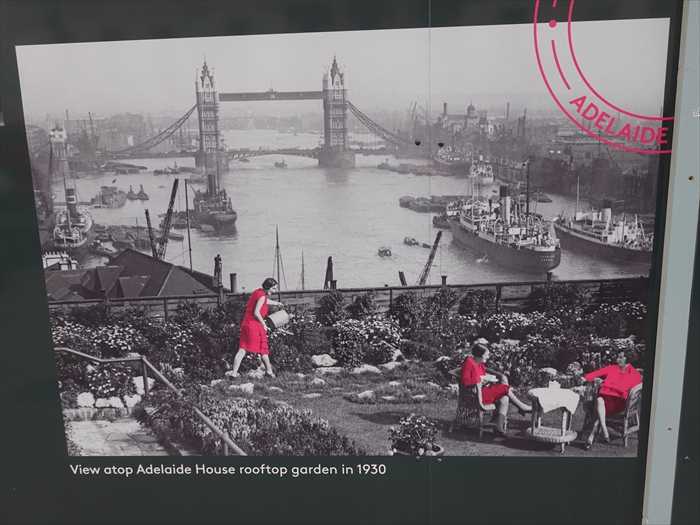
「 1932年の縄跳び写真 」
「Women skipping on the Adelaide House rooftop in 1932
BLOOM & GROW WITH REAL PROMINENCE
【1932年、アデレード・ハウス屋上で縄跳びをする女性たち
大きな存在感をもって咲き誇り、成長する

このドームのある建築物の名前は Guardian Assurance Plc の建物。
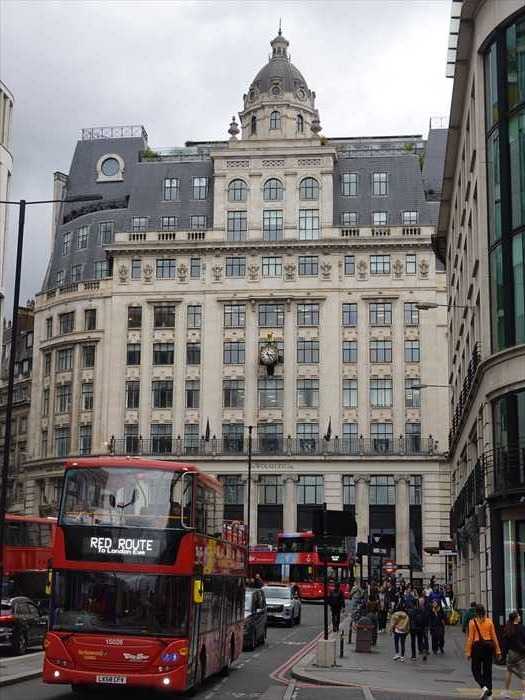
右手奥にあったのが
「 ロンドン大火記念柱(The Monument to the Great Fire of London) 」。
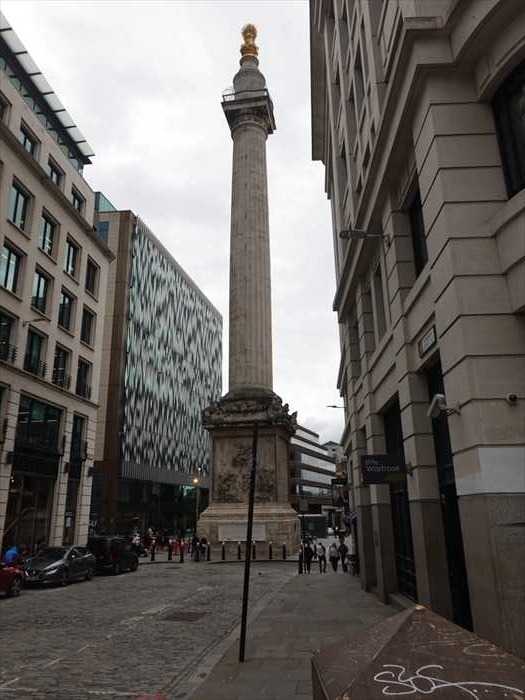
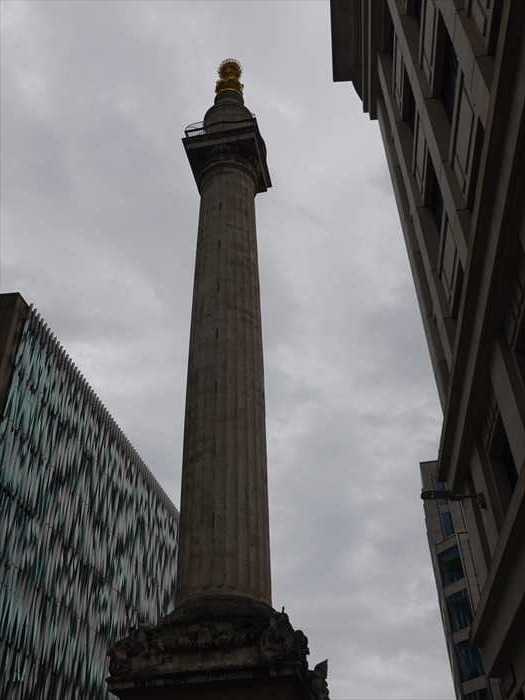
金色の炎をかたどったオーブ(火の玉) をズームして。
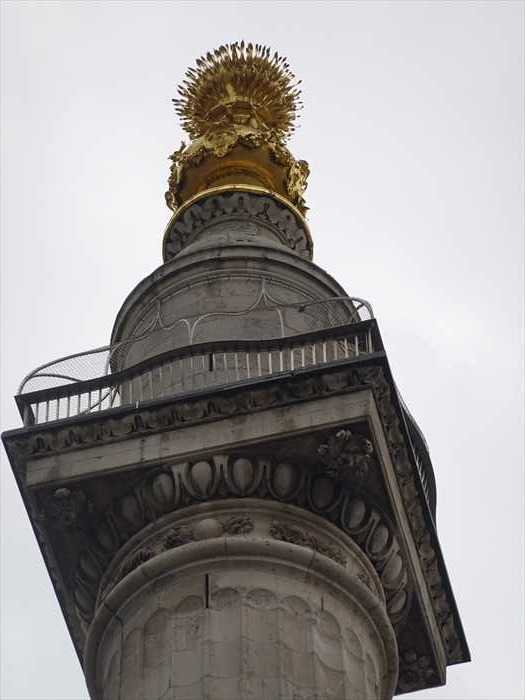
ネットから。

内部階段、これもネットから。
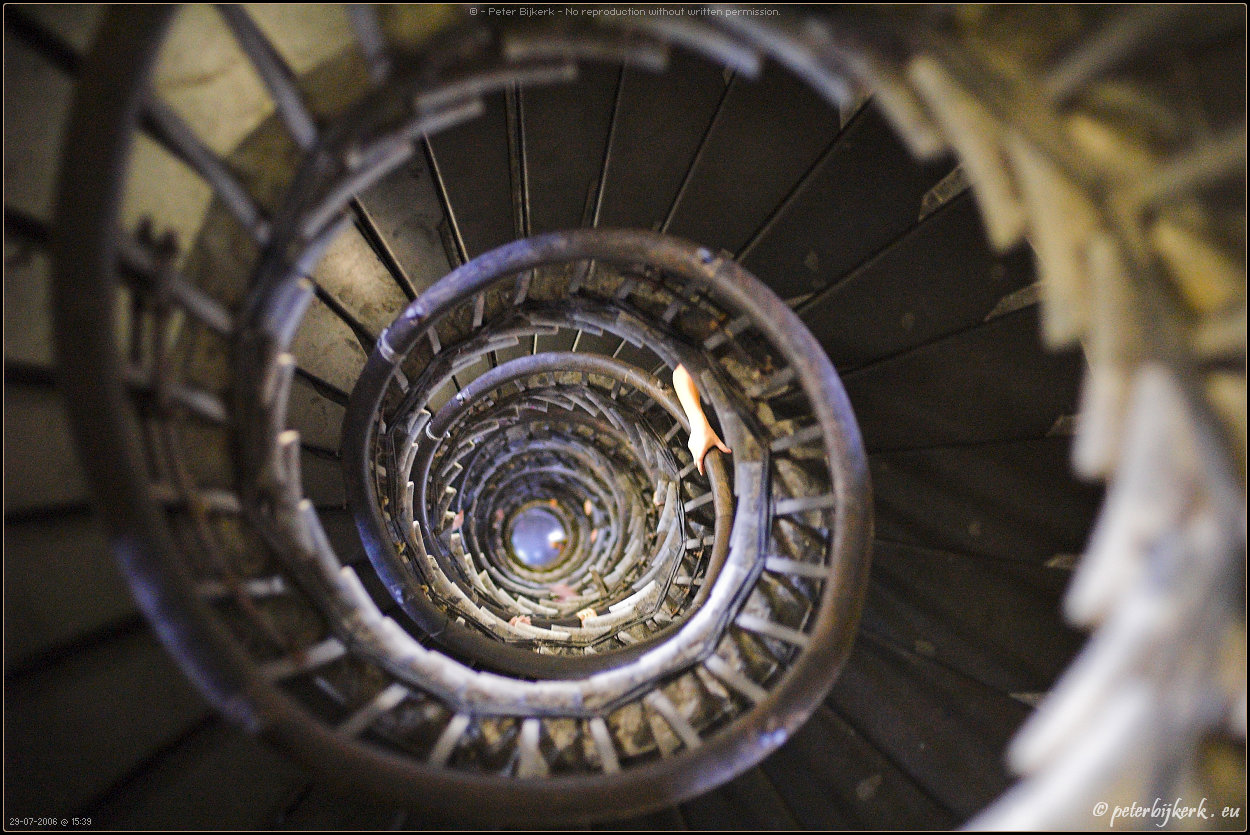
に施された
大きな浮彫(レリーフ) 。
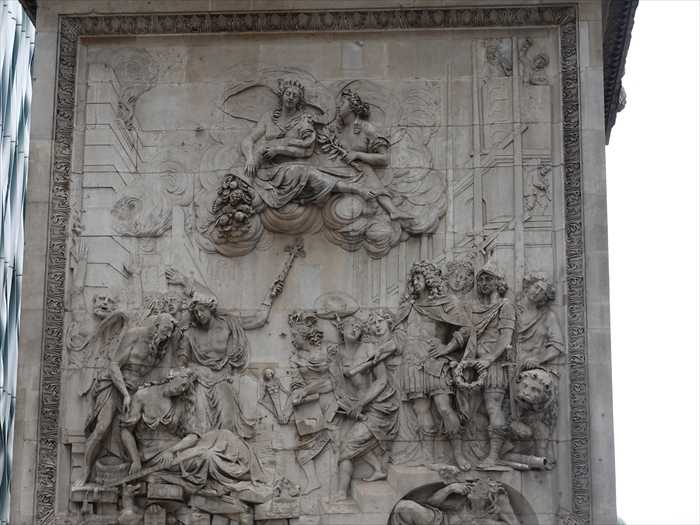
ロンドン大火記念柱(The Monument)基壇の大レリーフ の 上部中央部分をクローズアップ 。
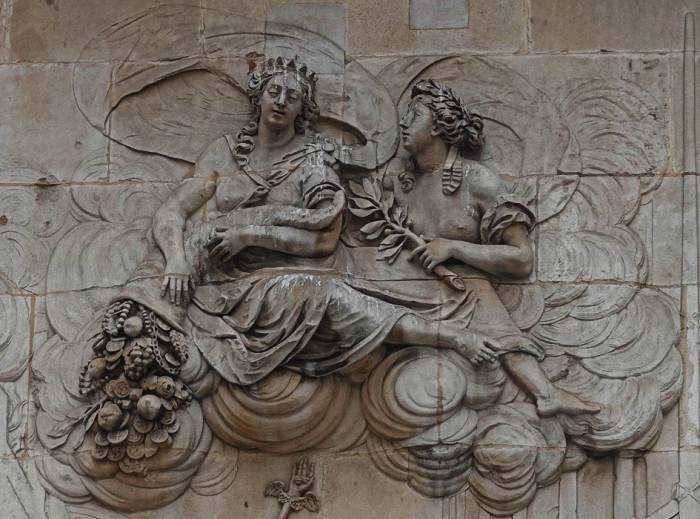
基壇レリーフの右側部分 をクローズアップ。

基壇レリーフの左側部分 をクローズアップ。

「 THE MONUMENT
くつろぎのひとときを楽しんでいるのであった。

Adelaide House(アデレード・ハウス)の屋上庭園 から見た1930年当時の景観。
・女性がジョウロを持って植物に水をやっている姿は、当時も都会の屋上庭園が生活と直結
していたことを伝えているのであった。

「 1932年の縄跳び写真 」
「Women skipping on the Adelaide House rooftop in 1932
BLOOM & GROW WITH REAL PROMINENCE
Adelaide House has always been a place to foster bright minds.
A pioneering development, with spectacular views,
helping you attract and retain the very best talent.」 【1932年、アデレード・ハウス屋上で縄跳びをする女性たち
大きな存在感をもって咲き誇り、成長する
アデレード・ハウスは常に優れた知性を育む場であり続けてきました。
革新的な開発であり、壮観な眺望を備え、
最高の人材を引き寄せ、維持する手助けをしてきました。】 
このドームのある建築物の名前は Guardian Assurance Plc の建物。
・所在地:68 King William St, London EC4N 7HR
🏛️建築概要:
かつての保険会社 Guardian Assurance Company(ガーディアン保険) の本社として
建てられたもので、
建てられたもので、
ロンドン金融街(シティ)の中心部、バンク交差点(Bank Junction)のすぐそばにあります。
ファサード中央に見える金色のガーディアン(守護天使)の像と大時計が有名な意匠。
現在は「60 Lombard Street」としてオフィスビルに転用されています。
💡特徴
設計:20世紀初頭、エドワード様式(Edwardian Baroque)に分類される壮麗な石造建築。
頂部のドーム屋根と両翼のマンサード屋根(mansard roof)が印象的。
中央部の大時計の上に立つ金色の像は、守護の象徴“Guardian”を具現化したもの。

右手奥にあったのが
「 ロンドン大火記念柱(The Monument to the Great Fire of London) 」。
・正式名称:T
he Monument to the Great Fire of London
・建設期間:
1671年〜1677年
・設計者:
サー・クリストファー・レン(Sir Christopher Wren) とロバート・フック
(Robert Hooke)
(Robert Hooke)
・高さ:61.57メートル
(202フィート)
・大火が始まった プディング・レーン(Pudding Lane) のパン屋の跡地からの距離と
同じ高さに設計されています。
同じ高さに設計されています。
・目的:1666年の ロンドン大火(Great Fire of London) を記念
し、また 復興を象徴する
記念碑 として建設。
記念碑 として建設。
ロンドン大火とは
・ 発生:1666年9月2日
、プディング・レーンのパン屋から出火。
・ 被害:シティ・オブ・ロンドンの大部分を焼失し、87の教会と約13,200軒の家屋が消失
。
・影響:ロンドンの都市計画と建築基準が大きく改められる契機となった。

Monument の特徴
・頂上部分:金色の炎をかたどったオーブ(火の玉)
。
・内部:螺旋階段(311段)
を登ると、展望デッキからシティ・オブ・ロンドンとテムズ川を
一望できます。
一望できます。
・位置:Monument Street と Fish Street Hill の交差点、ロンドン橋とタワーブリッジの
中間地点にあります。
中間地点にあります。
・文化的意義:ロンドンのシティにおける最も有名なランドマークのひとつで、 地下鉄
「Monument駅」の名称の由来 にもなっている。
「Monument駅」の名称の由来 にもなっている。

金色の炎をかたどったオーブ(火の玉) をズームして。

ネットから。

内部階段、これもネットから。

に施された
大きな浮彫(レリーフ) 。
・ 作者:
カイウス・ガブリエル・シブベル(Caius Gabriel Cibber, 1630–1700)
・ 題材:
1666年のロンドン大火と、その後の復興を寓意的に表現。
・ 配置:
モニュメント基壇の西側に設置されており、通行者から正面で見える位置。

ロンドン大火記念柱(The Monument)基壇の大レリーフ の 上部中央部分をクローズアップ 。
1.左側の人物(冠をかぶった翼のある女性像)
・王冠のようなものを頭にいただき、背に翼をもち、右手からは果物や穀物の束が豊かに
こぼれ落ちています。
こぼれ落ちています。
・これは 豊穣(Abundance, Plenty) または 繁栄(Prosperity) を擬人化した存在。
・ロンドンが再び豊かさを取り戻すことを象徴。
2.右側の人物(若い女性像、オリーブの枝を持つ)
・手にオリーブの枝を持ち、平和を象徴する姿。
・これは 平和(Peace) の寓意像。
・大火後の混乱の終息と、平和な復興時代の到来を示している。

基壇レリーフの右側部分 をクローズアップ。
1.左の人物(長髪でマントを纏う)
・王冠をいただき、中央に堂々と立っている人物は チャールズ2世(Charles II) を
寓意的に表したもの。
寓意的に表したもの。
・右手を前方に差し出し、ロンドン再建の指揮を執る姿を示している。
2.中央奥の冠を被る人物
・こちらも王権や統治を象徴する補助的な寓意像と解釈される場合がある。
・チャールズの正統性を強調する「王権の擬人像」とされることが多い。
3.右手前の人物(兜をかぶり、月桂冠を持つ)
・戦士風の姿で、手に持つ月桂冠は 勝利(Victory) の象徴。
・ロンドンが試練を克服し、新しい都市として「勝利」することを意味。
4.最右の人物(獅子の頭を掲げる)
・ライオンはイングランド王国を象徴。
・王の力と国家の威厳を表している。

基壇レリーフの左側部分 をクローズアップ。
1.中央下の女性(倒れ込む姿)
・都市ロンドンを寓意化した女性像。
・崩壊した都市と市民の苦悩を表現し、力尽きて横たわっている。
2.左の老人(長い髭をもつ半裸の男性)
・「時(Time)」を象徴する人物。
・老いた姿で力強く女性(ロンドン)を支え、時間が再生をもたらすことを示している。
3.右の女性(胸をはだけて優しく支える)
・「真実(Truth)」または「慈悲(Compassion)」の寓意像。
・ロンドンを慰め、復興への希望を伝える存在。
4.背後の天使(翼をもつ)
・神の加護や守護を象徴。
・災厄から救済へ導く天的な存在を強調。

「 THE MONUMENT
The Monument, designed by Robert Hooke FRS in consultation with Sir Christopher Wren,
was built 1671–1677, on the site of St Margaret Fish Street Hill, to commemorate
the Great Fire of London 1666. The fire burnt from 2 to 5 September, devastating
two-thirds of the City, and destroyed 13,200 houses, 87 churches, and 52 Livery
Company Halls.
was built 1671–1677, on the site of St Margaret Fish Street Hill, to commemorate
the Great Fire of London 1666. The fire burnt from 2 to 5 September, devastating
two-thirds of the City, and destroyed 13,200 houses, 87 churches, and 52 Livery
Company Halls.
The Monument, a freestanding fluted Doric column topped by a flaming copper urn,
is 61m/202ft in height, being equal to the distance westward from the site of the bakery
in Pudding Lane where the fire broke out. Its central shaft originally housed lenses for a
zenith telescope and its balcony, reached by an internal spiral staircase of 311 steps,
affords panoramic views of the City. The allegorical sculpture on the pedestal above was
executed by Caius Gabriel Cibber and shows Charles II coming to assist the slumped
figure of the City of London.
is 61m/202ft in height, being equal to the distance westward from the site of the bakery
in Pudding Lane where the fire broke out. Its central shaft originally housed lenses for a
zenith telescope and its balcony, reached by an internal spiral staircase of 311 steps,
affords panoramic views of the City. The allegorical sculpture on the pedestal above was
executed by Caius Gabriel Cibber and shows Charles II coming to assist the slumped
figure of the City of London.
ST MAGNUS THE MARTYR
Fish Street Hill, to the south, leads to St Magnus the Martyr, a Wren church, alongside
which is the ancient street which led to the medieval London Bridge.」
【 モニュメント(大火記念柱)
which is the ancient street which led to the medieval London Bridge.」
【 モニュメント(大火記念柱)
モニュメントは、ロバート・フック(FRS)がサー・クリストファー・レンと協議して設計し、
1666年のロンドン大火を記念するため、1671年から1677年にかけてセント・マーガレット教会
(フィッシュ・ストリート・ヒル跡地)に建てられました。
1666年のロンドン大火を記念するため、1671年から1677年にかけてセント・マーガレット教会
(フィッシュ・ストリート・ヒル跡地)に建てられました。
大火は9月2日から5日まで燃え続け、市の3分の2を壊滅させ、13,200軒の家屋、87の教会、
52の同業組合ホールを焼失させました。
52の同業組合ホールを焼失させました。
モニュメントは、頂上に炎をかたどった銅製の壺を戴く独立したフルート付きドーリス式円柱で、
高さ61メートル(202フィート)。これは火災が発生したプディング・レーンのパン屋跡から
西に離れた距離と等しい高さです。
高さ61メートル(202フィート)。これは火災が発生したプディング・レーンのパン屋跡から
西に離れた距離と等しい高さです。
中央のシャフトは当初、天頂望遠鏡のレンズを収めるためのもので、内部の311段の螺旋階段を
上った先のバルコニーからはシティを一望できます。
上った先のバルコニーからはシティを一望できます。
基壇上の寓意的な彫刻はカイウス・ガブリエル・シブベルによって制作され、倒れ込む
ロンドン市の擬人像を助けに来るチャールズ2世を表しています。
ロンドン市の擬人像を助けに来るチャールズ2世を表しています。
聖マグナス教会(St Magnus the Martyr)
フィッシュ・ストリート・ヒルを南へ行くと、レン設計の聖マグナス教会に至ります。
その横には、中世ロンドン橋へと通じていた古代の通りがあります。】
その横には、中世ロンドン橋へと通じていた古代の通りがあります。】

ロンドン大火記念柱(The Monument)基壇のラテン語銘文。
【キリスト紀元1666年9月4日、
都市の東部で火災が発生した。
その後2日間、猛烈な風に煽られた火は、
37の教会、城門、大通り、市場、公共建物、学校、図書館、
そして約13,200軒の家屋を焼き尽くし、
繁栄を誇ったこの都市の大部分を灰燼に帰した。
3日目には、人間の力も手段も尽き果て、
まるで世界全体が最終的な炎で滅びるかのように思われた。
しかし、ついに天の意志により、この宿命の火は鎮まり、
あらゆる場所で燃え尽きた。】

「TRANSLATION OF THE LATIN INSCRIPTION ABOVE
Charles the Second, son of Charles the Martyr, King of Great Britain, France and Ireland,
Defender of the Faith, a most Gracious Prince, commiserating the deplorable state of
things, whilst the ruins were yet smoking, provided for the comfort of his citizens and
the ornament of his city; remitted their taxes, and referred the consideration of the
reparation of the Magistrates and Inhabitants of London to the Parliament, who
immediately passed an Act that public works should be restored to a greater beauty,
with public money to be raised by an imposition on coals, that churches, and the
Cathedral of St Paul’s should be rebuilt from their foundations, with great magnificence;
that the bridges, gates and prisons should be new made; the sewers cleansed;
the streets made straight and regular; such as were steep levelled and those too narrow
made wider, markets and shambles removed to separate places. They also enacted
that every house should be built with party-walls, and all raised of an equal height
in front; and that all house-walls should be strengthened with stone or brick; and that
no man should delay building beyond the space of seven years. Furthermore, he procured
an Act to settle beforehand the differences about meum and tuum (mine and yours),
boundaries also being settled. An annual service of intercession was also established,
and he caused this column to be erected as a perpetual memorial to posterity. Jesus
it seems everywhere, London rises again, whether with greater speed or greater
magnificence is doubtful. Three short years complete that which was considered
the work of an age.」
【大ブリテン、フランスおよびアイルランドの王にして信仰の守護者である「殉教王チャールズ」
の子、チャールズ2世は、最も寛大な君主として、まだ廃墟が燻っていた頃に惨状を嘆き、市民の
慰めと都市の美観のために施策を講じた。彼は市民の税を免除し、ロンドンの復興に関する検討を
議会と市当局に委ねた。議会は直ちに法律を制定し、公費を石炭税で賄い、公共施設をより美しく
再建することを決めた。
Defender of the Faith, a most Gracious Prince, commiserating the deplorable state of
things, whilst the ruins were yet smoking, provided for the comfort of his citizens and
the ornament of his city; remitted their taxes, and referred the consideration of the
reparation of the Magistrates and Inhabitants of London to the Parliament, who
immediately passed an Act that public works should be restored to a greater beauty,
with public money to be raised by an imposition on coals, that churches, and the
Cathedral of St Paul’s should be rebuilt from their foundations, with great magnificence;
that the bridges, gates and prisons should be new made; the sewers cleansed;
the streets made straight and regular; such as were steep levelled and those too narrow
made wider, markets and shambles removed to separate places. They also enacted
that every house should be built with party-walls, and all raised of an equal height
in front; and that all house-walls should be strengthened with stone or brick; and that
no man should delay building beyond the space of seven years. Furthermore, he procured
an Act to settle beforehand the differences about meum and tuum (mine and yours),
boundaries also being settled. An annual service of intercession was also established,
and he caused this column to be erected as a perpetual memorial to posterity. Jesus
it seems everywhere, London rises again, whether with greater speed or greater
magnificence is doubtful. Three short years complete that which was considered
the work of an age.」
【大ブリテン、フランスおよびアイルランドの王にして信仰の守護者である「殉教王チャールズ」
の子、チャールズ2世は、最も寛大な君主として、まだ廃墟が燻っていた頃に惨状を嘆き、市民の
慰めと都市の美観のために施策を講じた。彼は市民の税を免除し、ロンドンの復興に関する検討を
議会と市当局に委ねた。議会は直ちに法律を制定し、公費を石炭税で賄い、公共施設をより美しく
再建することを決めた。
聖ポール大聖堂と諸教会は基礎から再建され、壮麗さをもって復興された。橋や城門、牢獄も
新しく建て直され、下水は清掃され、通りは真っすぐ整然とされ、急な坂は平らにされ、狭すぎる
道は拡幅され、市場や屠殺場は他所へ移された。
新しく建て直され、下水は清掃され、通りは真っすぐ整然とされ、急な坂は平らにされ、狭すぎる
道は拡幅され、市場や屠殺場は他所へ移された。
また、すべての家屋は防火壁を設け、正面の高さを揃え、壁は石やレンガで補強することとされた。
さらに、いかなる者も7年を超えて建築を遅らせてはならないとされた。加えて、土地の境界や
所有権の争いを事前に解決するための法律も制定された。
さらに、いかなる者も7年を超えて建築を遅らせてはならないとされた。加えて、土地の境界や
所有権の争いを事前に解決するための法律も制定された。
毎年の祈祷式も定められ、そして後世への永遠の記念として、この記念柱(モニュメント)が
建てられた。
建てられた。
イエスの御名のもと、ロンドンはあらゆる場所で再び立ち上がった。その復興が速さにおいて
勝っていたのか、壮麗さにおいて勝っていたのかは定かでない。わずか3年にして、人々が
「一世代を要する」と考えていた復興を完成させたのである。】
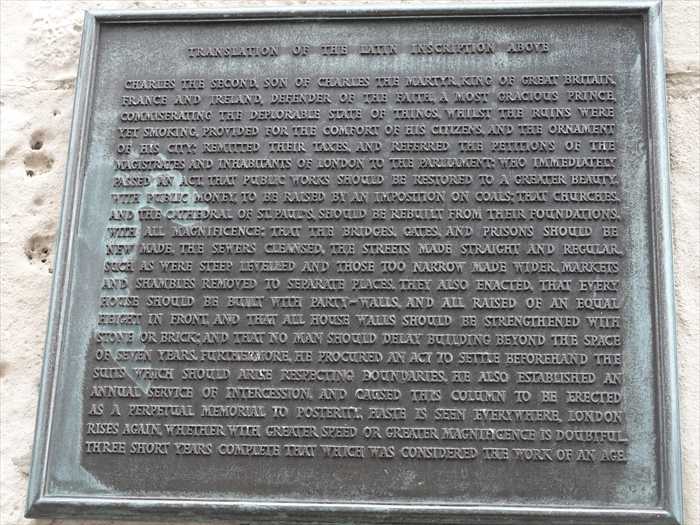
再び見上げて。
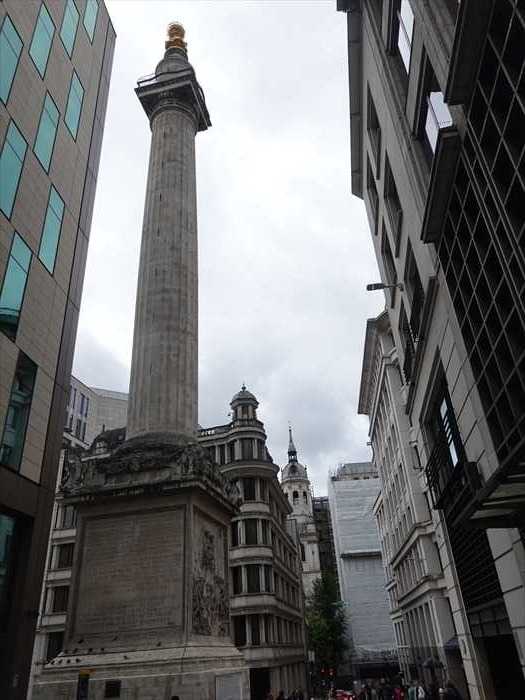
ロンドン・シティ地区に設置されている 観光・徒歩案内マップ。
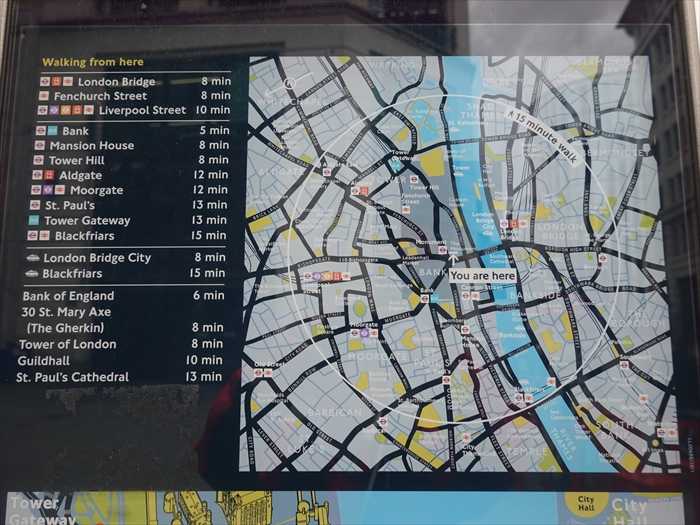
ロンドンの街歩き用 エリアマップ。
先ほどの案内板より範囲が広く、特に T ower of London(ロンドン塔)からLondon Bridge
(ロンドン橋)周辺まで がしっかり描かれていた。
・中央に「 You are here(現在地) 」が記されており、Monument駅周辺にいることがわかる。
・外周には「15 minute walk」の円があり、徒歩圏を直感的に示していた。

ロンドン大火記念柱(The Monument) の前から テムズ川方向 の道の奥に見えたのが
「St Magnus the Martyr Church(聖マグナス教会) 」の尖塔。
ロンドン大火(1666年)でこの教会も焼失したが、都市復興の一環として再建。
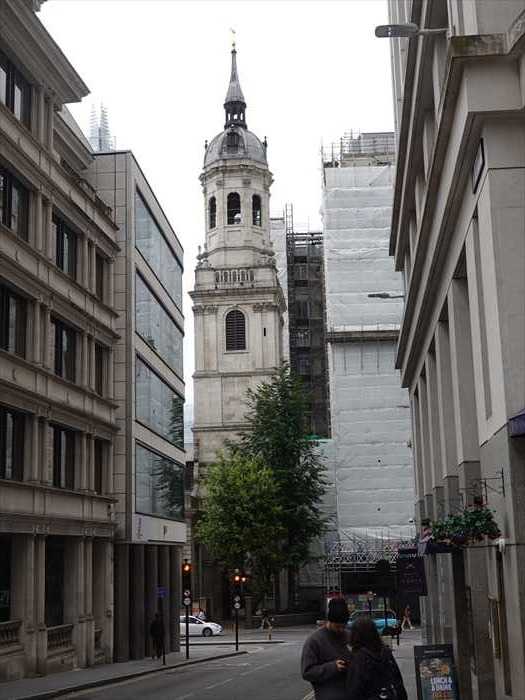
・ 再建:1671~1687年 、サー・クリストファー・レンの設計で再建。
勝っていたのか、壮麗さにおいて勝っていたのかは定かでない。わずか3年にして、人々が
「一世代を要する」と考えていた復興を完成させたのである。】

再び見上げて。

ロンドン・シティ地区に設置されている 観光・徒歩案内マップ。
・テムズ川を中央にして北側(シティ側)と南側(サザーク側)が描かれている。
・黒線で道路、青で川、黄で主要建物・観光地がマークされている。
・外周に「15 minute walk(徒歩15分圏内)」の円が描かれており、徒歩で移動できる範囲を
示している。
示している。

ロンドンの街歩き用 エリアマップ。
先ほどの案内板より範囲が広く、特に T ower of London(ロンドン塔)からLondon Bridge
(ロンドン橋)周辺まで がしっかり描かれていた。
・中央に「 You are here(現在地) 」が記されており、Monument駅周辺にいることがわかる。
・外周には「15 minute walk」の円があり、徒歩圏を直感的に示していた。

ロンドン大火記念柱(The Monument) の前から テムズ川方向 の道の奥に見えたのが
「St Magnus the Martyr Church(聖マグナス教会) 」の尖塔。
ロンドン大火(1666年)でこの教会も焼失したが、都市復興の一環として再建。

・ 再建:1671~1687年 、サー・クリストファー・レンの設計で再建。
・ 建築様式:バロック様式
。白いポートランド石で造られ、特徴的な塔(尖塔を持つ)は
1725年に完成。
1725年に完成。
・特徴:
・内部は華やかなバロック装飾が施され、祭壇や説教壇は細かな彫刻で彩られている。
・ロンドン橋に隣接していたため、橋を渡る人々が必ず目にしたランドマーク。
・歴史的に、ロンドン橋の入口に位置する「門の教会」の役割を果した。

ロンドンの有名な高層ビル
20 Fenchurch Street(通称:ウォーキー・トーキー / Walkie Talkie)。
・完成:2014年

ロンドンの有名な高層ビル
20 Fenchurch Street(通称:ウォーキー・トーキー / Walkie Talkie)。
・完成:2014年
・高さ:160 m(層数 38階)
・設計者:ラファエル・ヴィニオリ(Rafael Viñoly)
・愛称:「ウォーキー・トーキー(トランシーバー)」
・独特の上に広がるフォルムから、ロンドン市民にこう呼ばれている と。
上部が張り出したデザインで、下部よりも上層階が大きい逆テーパー構造。
完成当初、反射光が集中して地上の車を「溶かす」ほどの熱を発生させたため、
「デス・レイ」ビルとも揶揄されました(後に修正済み)。

ドームのある建築物・Monument Place前 まで歩を進める。

セント・ポール大聖堂(St Paul’s Cathedral)の西側の時計塔(West Tower with Clock) 。
「デス・レイ」ビルとも揶揄されました(後に修正済み)。

ドームのある建築物・Monument Place前 まで歩を進める。

セント・ポール大聖堂(St Paul’s Cathedral)の西側の時計塔(West Tower with Clock) 。
設計は サー・クリストファー・レン、1710年に完成
。
ロンドン大火(1666年)の後、焼失した旧聖堂の跡地に建てられた再建聖堂。
左奥に青く光る部分が見えるのは BT Tower(旧名:Post Office Tower)
。
1960年代に建設された 高さ177mの通信塔
で、ロンドンのランドマークのひとつ。
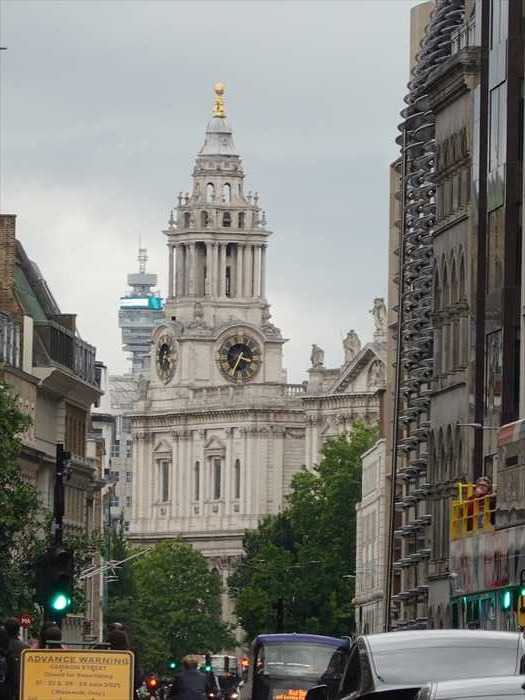
急に雨が降り出し、一時避難。

ロンドンの金融街「シティ(City of London)」の街並み、そして近代的な超高層ビルと
クラシカルな石造建築が並ぶ典型的な光景を見ながらの雨宿り。

小雨が降り続けていたので、この日のロンドン市内の散策はこれまでとし、
セント・ポール大聖堂 ・St. Paul's Cathedralの散策は翌日とし、近くにあった
ロンドン地下鉄「モニュメント駅(Monument Station)」 へ向かった。

「モニュメント駅(Monument Station)」構内。

そして 「SOUTH KENJINTON」駅 で下車。

「SOUTH KENJINTON」駅から宿泊の民宿・アパートメントに向かったのであった。

・・・ もどる ・・・
・・・ つづく ・・・

急に雨が降り出し、一時避難。

ロンドンの金融街「シティ(City of London)」の街並み、そして近代的な超高層ビルと
クラシカルな石造建築が並ぶ典型的な光景を見ながらの雨宿り。

小雨が降り続けていたので、この日のロンドン市内の散策はこれまでとし、
セント・ポール大聖堂 ・St. Paul's Cathedralの散策は翌日とし、近くにあった
ロンドン地下鉄「モニュメント駅(Monument Station)」 へ向かった。

「モニュメント駅(Monument Station)」構内。

そして 「SOUTH KENJINTON」駅 で下車。

「SOUTH KENJINTON」駅から宿泊の民宿・アパートメントに向かったのであった。

・・・ もどる ・・・
・・・ つづく ・・・
お気に入りの記事を「いいね!」で応援しよう
【毎日開催】
15記事にいいね!で1ポイント
10秒滞在
いいね!
--
/
--
© Rakuten Group, Inc.










